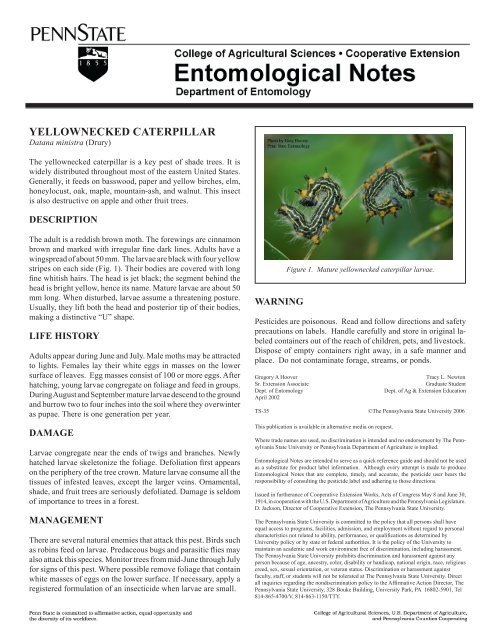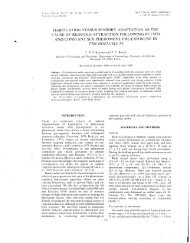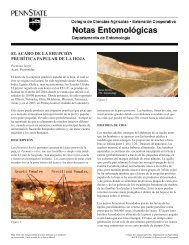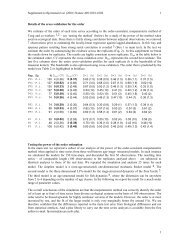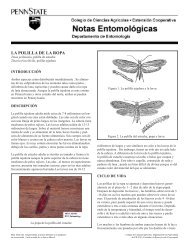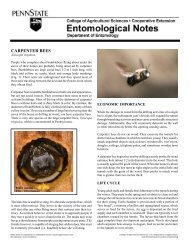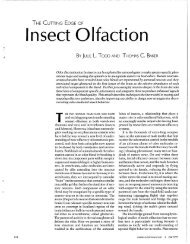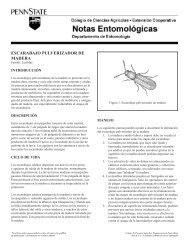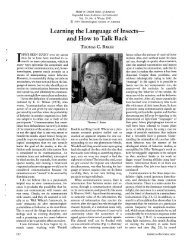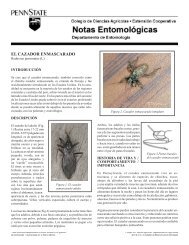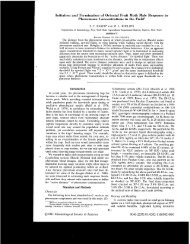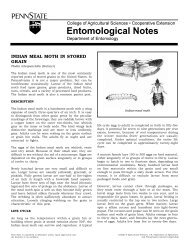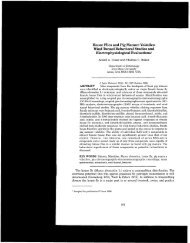PDF version of Yellownecked Caterpillar Fact Sheet - Entomology
PDF version of Yellownecked Caterpillar Fact Sheet - Entomology
PDF version of Yellownecked Caterpillar Fact Sheet - Entomology
Create successful ePaper yourself
Turn your PDF publications into a flip-book with our unique Google optimized e-Paper software.
<strong>Yellownecked</strong> <strong>Caterpillar</strong><br />
Datana ministra (Drury)<br />
The yellownecked caterpillar is a key pest <strong>of</strong> shade trees. It is<br />
widely distributed throughout most <strong>of</strong> the eastern United States.<br />
Generally, it feeds on basswood, paper and yellow birches, elm,<br />
honeylocust, oak, maple, mountain-ash, and walnut. This insect<br />
is also destructive on apple and other fruit trees.<br />
Description<br />
The adult is a reddish brown moth. The forewings are cinnamon<br />
brown and marked with irregular fine dark lines. Adults have a<br />
wingspread <strong>of</strong> about 50 mm. The larvae are black with four yellow<br />
stripes on each side (Fig. 1). Their bodies are covered with long<br />
fine whitish hairs. The head is jet black; the segment behind the<br />
head is bright yellow, hence its name. Mature larvae are about 50<br />
mm long. When disturbed, larvae assume a threatening posture.<br />
Usually, they lift both the head and posterior tip <strong>of</strong> their bodies,<br />
making a distinctive “U” shape.<br />
Life History<br />
Adults appear during June and July. Male moths may be attracted<br />
to lights. Females lay their white eggs in masses on the lower<br />
surface <strong>of</strong> leaves. Egg masses consist <strong>of</strong> 100 or more eggs. After<br />
hatching, young larvae congregate on foliage and feed in groups.<br />
During August and September mature larvae descend to the ground<br />
and burrow two to four inches into the soil where they overwinter<br />
as pupae. There is one generation per year.<br />
Damage<br />
Larvae congregate near the ends <strong>of</strong> twigs and branches. Newly<br />
hatched larvae skeletonize the foliage. Defoliation first appears<br />
on the periphery <strong>of</strong> the tree crown. Mature larvae consume all the<br />
tissues <strong>of</strong> infested leaves, except the larger veins. Ornamental,<br />
shade, and fruit trees are seriously defoliated. Damage is seldom<br />
<strong>of</strong> importance to trees in a forest.<br />
management<br />
There are several natural enemies that attack this pest. Birds such<br />
as robins feed on larvae. Predaceous bugs and parasitic flies may<br />
also attack this species. Monitor trees from mid-June through July<br />
for signs <strong>of</strong> this pest. Where possible remove foliage that contain<br />
white masses <strong>of</strong> eggs on the lower surface. If necessary, apply a<br />
registered formulation <strong>of</strong> an insecticide when larvae are small.<br />
WARNING<br />
Gregory A Hoover<br />
Sr. Extension Associate<br />
Dept. <strong>of</strong> <strong>Entomology</strong><br />
April 2002<br />
Figure 1. Mature yellownecked caterpillar larvae.<br />
Pesticides are poisonous. Read and follow directions and safety<br />
precautions on labels. Handle carefully and store in original labeled<br />
containers out <strong>of</strong> the reach <strong>of</strong> children, pets, and livestock.<br />
Dispose <strong>of</strong> empty containers right away, in a safe manner and<br />
place. Do not contaminate forage, streams, or ponds.<br />
Tracy L. Newton<br />
Graduate Student<br />
Dept. <strong>of</strong> Ag & Extension Education<br />
TS-35 ©The Pennsylvania State University 2006<br />
This publication is available in alternative media on request.<br />
Where trade names are used, no discrimination is intended and no endorsement by The Pennsylvania<br />
State University or Pennsylvania Department <strong>of</strong> Agriculture is implied.<br />
Entomological Notes are intended to serve as a quick reference guide and should not be used<br />
as a substitute for product label information. Although every attempt is made to produce<br />
Entomological Notes that are complete, timely, and accurate, the pesticide user bears the<br />
responsibility <strong>of</strong> consulting the pesticide label and adhering to those directions.<br />
Issued in furtherance <strong>of</strong> Cooperative Extension Works, Acts <strong>of</strong> Congress May 8 and June 30,<br />
1914, in cooperation with the U.S. Department <strong>of</strong> Agriculture and the Pennsylvania Legislature.<br />
D. Jackson, Director <strong>of</strong> Cooperative Extension, The Pennsylvania State University.<br />
The Pennsylvania State University is committed to the policy that all persons shall have<br />
equal access to programs, facilities, admission, and employment without regard to personal<br />
characteristics not related to ability, performance, or qualifications as determined by<br />
University policy or by state or federal authorities. It is the policy <strong>of</strong> the University to<br />
maintain an academic and work environment free <strong>of</strong> discrimination, including harassment.<br />
The Pennsylvania State University prohibits discrimination and harassment against any<br />
person because <strong>of</strong> age, ancestry, color, disability or handicap, national origin, race, religious<br />
creed, sex, sexual orientation, or veteran status. Discrimination or harassment against<br />
faculty, staff, or students will not be tolerated at The Pennsylvania State University. Direct<br />
all inquiries regarding the nondiscrimination policy to the Affirmative Action Director, The<br />
Pennsylvania State University, 328 Bouke Building, University Park, PA 16802-5901, Tel<br />
814-865-4700/V, 814-863-1150/TTY.


